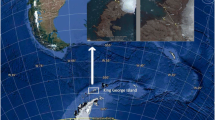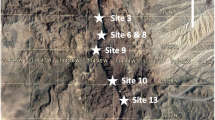Abstract
Despite detailed study of selected thermophilic taxa, overall community diversity of bacteria in thermophilic mats remains relatively poorly understood. A sequence-based survey of bacterial communities from several hot spring locations in central Tibet was undertaken. Diversity and frequency of occurrence for 140 unique 16S rRNA gene phylotypes were identified in clone libraries constructed from environmental samples. A lineage-per-time plot revealed that individual locations have evolved to support relatively large numbers of phylogenetically closely related phylotypes. Application of the F ST statistic and P test to community data was used to demonstrate that phylogenetic divergence between locations was significant, thus emphasizing the status of hot springs as isolated habitats. Among phylotypes, only the Chlorobi were ubiquitous to all mats, other phototrophs (Cyanobacteria and Chloroflexi) occurred in most but not all samples and generally accounted for a large number of recovered phylotypes. Phylogenetic analyses of phototrophic phylotypes revealed support for location-specific lineages. The alpha, beta and gamma proteobacteria were also frequently recovered phyla, suggesting they may be abundant phylotypes in mats, a hitherto unappreciated aspect of thermophilic mat biodiversity. Samples from one location indicated that where phototrophic bacteria were rare or absent due to niche disturbance, the relative frequency of proteobacterial phylotypes increased.




Similar content being viewed by others
References
Aitchison JC, Davis AM, Badengzhu, Luo H (2002) New constraints on the India–Asia collision: The Lower Miocene Gangrinboche conglomerates, Yarlung Tsangpo suture zone, SE Tibet. J Asian Earth Sci 21: 253–265
Baker GC, Shabarni G, Cowan DA, Suharto AR (2001) Bacterial community analysis of Indonesian hot springs. FEMS Microbiol Lett 200:103–109
Bateson MM, Ward DM (1988) Photoexcretion and consumption of glycolate in a hot spring cyanobacterial mat. Appl Environ Microbiol 54:1738–1743
Chao A, Ma M-C, Yang M (1993) Stopping rules and estimation for recapture debugging with unequal failure rates. Biometrika 80:193–201
Clarke KR, Warwick RM (2001) Change in marine communities: an approach to statistical analysis and interpretation, 2nd edn. Primer-E, Plymouth
Cohan FM (2002) What are bacterial species? Ann Rev Microbiol 56:457–487
Curtis TP, Sloan WT, Scannell JW (2001) Estimating prokaryotic diversity and its limits. Proc Natl Acad Sci USA 99:10494–10499
de la Torre JR, Goebel BR, Friedmann EI, Pace NR (2003) Microbial diversity of cryptoendolithic communities from the McMurdo dry valleys, Antarctica. Appl Environ Microbiol 69:3858–3867
Excoffier LGL, Schneider S (2005) Arlequin v3.0: An integrated software package for population genetics data analysis. Evol Bioinform online 1:47–50
Ferrer M, Golyshina O, Beloqui A, Golyshni P (2007) Mining enzymes from extreme environments. Curr Opin Microbiol 10:207–214
Ferris MJ, Ward DM (1997) Seasonal distributions of dominant 16S rRNA-defined populations in a hot spring microbial mat examined by denaturing gradient gel electrophoresis. Appl Environ Microbiol 63:1375–1381
Ferris MJ, Nold SC, Revsbech NP, Ward DM (1997) Population structure and physiological changes within a hot spring microbial mat community following disturbance. Appl Environ Microbiol 63:1367–1374
Good IL (1953) The population frequencies of species and the estimation of population parameters. Biometrika 80:193–201
Hugenholtz P, Pitulle C, Hershberger KL, Pace NR (1998) Novel division level bacterial diversity in a Yellowstone hot spring. J Bacteriol 180:366–376
Hughes Martiny JB, Bohannan BJM, Brown JH, Colwell RK et al (2006) Microbial biogeography: putting microorganisms on the map. Nature Rev Microbiol 4:102–112
Jing HM, Aitchison JC, Lacap DC, Peeraornpisal Y, Sompong U, Pointing SB (2005) Community phylogenetic analysis of moderately thermophilic cyanobacterial mats from China, The Philippines and Thailand. Extremophiles 9:325–332
Jing H, Lacap DC, Lau CY, Pointing SB (2006) Community phylogenetic diversity of cyanobacterial mats associated with geothermal springs along a tropical intertidal gradient. Extremophiles 10:159–163
Lacap DC, Smith GJD, Warren-Rhodes K, Pointing SB (2005) Community structure of free-floating filamentous cyanobacterial mats from the Wonder Lake geothermal springs in the Philippines. Can J Microbiol 51:583–589
Lacap DC, Barraquio W, Pointing SB (2007) Thermophilic microbial mats in a tropical geothermal location display pronounced seasonal changes but appear resilient to stochastic disturbance. Environ Microbiol 9:3065–3076
Lau CY, Jing HM, Aitchison JC, Pointing SB (2006) Highly diverse community structure in a remote central Tibetan geothermal spring does not display monotonic variation to thermal stress. FEMS Microbiol Ecol 57:80–91
Lloyd H, Zar JH, Karr JR (1968) On the calculation of information—theoretical measures of diversity. Am Mid Nat 79:257–272
Maddison WP, Maddison DR (2001) MacClade v4.0.3, Sinauer Associates. Sunderland, MA, USA
Martin AP (2002) Phylogenetic approaches for describing and comparing the diversity of microbial communities. Appl Environ Microbiol 68:3673–3682
Nold SC, Kopczynski ED, Ward DM (1996) Cultivation of chemoorganotrophic proteobacteria and Gram-positive bacteria from a hot spring microbial mat. Appl Environ Microbiol 62:3917–3921
Norris TB, McDermott TR, Castenholz RW (2002) The long-term effects of UV exclusion on the microbial composition and photosynthetic competence of bacteria in hot-spring microbial mats. FEMS Microbiol Ecol 39:193–209
Papke RT, Ramsing NB, Bateson MM, Ward DM (2003) Geographical isolation in hot spring cyanobacteria. Environ Microbiol 5:650–659
Pielou EC (1966) The measurement of diversity in different types of biological collections. J Theor Biol 13:131–144
Purcell D, Sompong U, Lau CY, Barraclough TG, Peerapornpisal Y, Pointing SB (2007) The effects of temperature, pH and sulphide on community structure of hyperthermophilic streamers in hot springs of northern Thailand. FEMS Microbiol Ecol 60:456–466
Roeselers G, Norris TB, Castenholz RW, Rysgaard S, Glud RN, Kühl M, Muyzer G (2006) Diversity of phototrophic bacteria in microbial mats from Arctic hot springs (Greenland). Environ Microbiol 9:26–38
Santegoeds CM, Nold SC, Ward DM (1996) Denaturing gradient gel electrophoresis used to monitor the enrichment culture of aerobic chemoorganotrophic bacteria from a hot spring cyanobacterial mat. Appl Environ Microbiol 62:3922–3928
Schiraldi C, de Rosa M (2002) The production of biocatalysts and biomolecules from extremophiles. Trends Biotechnol 20:515–521
Skirnisdottir S, Hreggvidsson GO, Hjorleifsdottir S, Marteinsson VT et al (2000) Influence of sulfide and temperature on species composition and community structure of hot spring microbial mats. Appl Environ Microbiol 66:2835–2841
Swofford DL (2001) PAUP*: Phylogenetic analysis using parsimony (*and other methods) version 4.0b8. Sinauer Associates. Sunderland, MA, USA
Takacs-Vesbach C, Mitchell K, Jackson-Weaver O, Reysenbach A-L (2008) Volcanic calderas delineate biogeographic provinces among Yellowstone thermophiles. Environ Microbiol 10:1681–1689
Taylor M, Yin A, Ryerson FJ, Kapp P, Ding L (2003) Conjugate strike-slip faulting along the Bangong-Nujiang suture zone accommodates coeval east-west extension and north-south shortening in the interior of the Tibetan Plateau. Tectonics 22:1044
Thompson JD, Gibson TJ, Plewniak F, Jeanmougin F, Higgins DG (1997) The Clustal X Windows interface: flexible strategies for multiple sequence alignment aided by quality analysis tools. Nucl Acids Res 24:4876–4882
Ward DM, Castenholz RW (2000) Cyanobacteria in geothermal habitats. In: Whitton BA, Potts M (eds) The ecology of cyanobacteria: their diversity in time and space. Kluwer, Dordrecht, pp 37–59
Ward DM, Ferris MJ, Nold SC, Bateson MM (1998) A natural view of microbial biodiversity within hot spring cyanobacterial mat communities. Microbiol Mol Biol Rev 62:1353–1370
Whitaker RJ, Grogan DW, Taylor JW (2003) Geographical barriers isolate endemic population of hyperthermophilic archaea. Science 301:976–978
Wickstrom CE, Castenholz RW (1985) Dynamics of cyanobacterial and ostracod interactions in an Oregon hot spring. Ecology 66:1024–1041
Acknowledgments
The authors are grateful to the Tibet Ministry of Geology for fieldwork assistance. This research was supported by the Research Grants Council of Hong Kong (grant number HKU 7573/05M), and the Stephen S.·F. Hui Trust Fund.
Author information
Authors and Affiliations
Corresponding author
Additional information
Communicated by A. Driessen.
Electronic supplementary material
Below is the link to the electronic supplementary material.
Rights and permissions
About this article
Cite this article
Lau, M.C.Y., Aitchison, J.C. & Pointing, S.B. Bacterial community composition in thermophilic microbial mats from five hot springs in central Tibet. Extremophiles 13, 139–149 (2009). https://doi.org/10.1007/s00792-008-0205-3
Received:
Accepted:
Published:
Issue Date:
DOI: https://doi.org/10.1007/s00792-008-0205-3




